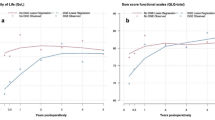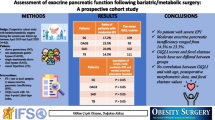Abstract
Background
Improvements in survival after pancreaticoduodenectomy has increased the number of patients potentially at risk of pancreatic insufficiency.
Aims
We studied long-term (> 1 year) pancreatic functions (endocrine and exocrine) after pancreaticoduodenectomy and aimed to recognize the impact of various clinicopathological factors and postoperative complications on pancreatic functions.
Methods
All patients who underwent pancreaticoduodenectomy at least 1 year prior were recruited from July 2020 to December 2021. Endocrine function was assessed using HbA1c, fasting blood sugar and postprandial blood sugar levels. Pancreatic exocrine function was assessed clinically with history of steatorrhea and objectively with quantitative estimation of fecal elastase-1 levels in stool samples. Volume of remnant pancreas, parenchymal thickness and duct diameter were assessed by computed tomography. Quality of life assessment was done using SF-36 questionnaire.
Results
Of the 106 patients assessed, 64 patients met the inclusion criteria. Endocrine insufficiency was noted in 51.6%, and 34.3% had new onset diabetes mellitus. The incidence of pancreatic exocrine insufficiency was 87.5% and severe insufficiency was found in 62.5% of patients. Twenty-nine (45.3%) patients had both exocrine and endocrine insufficiency. Patients with CRPOPF had higher risk of severe exocrine insufficiency (5 vs. 2, OR 1.57(0.28–8.81) p = 0.6). The SF-36 scores were lower than general population especially in role limitation due to physical health, role limitation due to emotional problems, energy/fatigue, general health perception and health change domains.
Conclusion
Post-pancreaticoduodenectomy patients have a high frequency of pancreatic insufficiency and should be screened for same. The post-operative pancreatic fistula increases the risk of pancreatic exocrine insufficiency.
Similar content being viewed by others
References
Cameron JL, Pitt HA, Yeo CJ, Lillemoe KD, Kaufman HS, Coleman J. One hundred and forty-five consecutive pancreaticoduodenectomies without mortality. Ann. Surg. 1993;217:430–438.
Greenblatt DY, Kelly KJ, Rajamanickam V, Wan Y, Hanson T, Rettammel R et al. Preoperative factors predict perioperative morbidity and mortality after pancreaticoduodenectomy. Ann. Surg. Oncol. 2011;18:2126–2135.
Kotwall CA, Maxwell JG, Brinker CC, Koch GG, Covington DL. National estimates of mortality rates for radical pancreaticoduodenectomy in 25,000 patients. Ann Surg. Oncol. 2002;9:847–854.
Sushma N, Gupta P, Kumar H et al. Role of ultrasound shear wave elastography in preoperative prediction of pancreatic fistula after pancreaticoduodenectomy. Pancreatology. 2020;20:1764–1769.
Singh H, Krishnamurthy G, Kumar H et al. Effect of bile duct clamping versus no clamping on surgical site infections in patients undergoing pancreaticoduodenectomy: a randomized controlled study. ANZ J Surg. 2020;90:1434–1440.
Yeo CJ, Cameron JL, Sohn TA et al. Six hundred fifty consecutive pancreatoduodenectomies in the 1990s: Pathology, complications, and outcomes. Ann Surg. 1997;226:248–260.
Haddad LB, Scatton O, Randone B, Andraus W, Massault PP, Dousset B et al. Pancreatic fistula after pancreaticoduodenectomy: the conservative treatment of choice. HPB (Oxford). 2009;11:203–209.
Zhou T, Sun J, Zhang Y, Zhou G, Nie C, Zhu T et al. Post-pancreaticoduodenectomy hemorrhage: DSA diagnosis and endovascular treatment. Oncotarget. 2017;8:73684–73692.
Deplanque G, Demartines N. Pancreatic cancer: are more chemo- therapy and surgery needed? Lancet. 2017;389:985–986.
Elliott IA, Epelboym I, Winner M, Allendorf JD, Haigh PI. Population-level incidence and predictors of surgically induced diabetes and exocrine insufficiency after partial pancreatic resection. Perm J. 2017;21:1–4.
Kusakabe J, Anderson B, Liu J, Williams GA, Chapman WC, Doyle MMB et al. Long-term endocrine and exocrine insufficiency after pancreatectomy. J Gastrointest. Surg. 2019;23:1604–1613.
Cherif R, Gaujoux S, Couvelard A, Dokmak S, Vuillerme MP, Ruszniewski P et al. Parenchyma-sparing resections for pancreatic neuroendocrine tumors. J Gastrointest. Surg. 2012;16:2045–2055.
Falconi M, Mantovani W, Crippa S, Mascetta G, Salvia R, Pederzoli P. Pancreatic insufficiency after different resections for benign tumours. Br. J. Surg. 2008;95:85–91.
Pathanki AM, Attard JA, Bradley E, Powell-Brett S, Dasari BVM, Isaac JR et al. Pancreatic exocrine insufficiency after pancreaticoduodenectomy: current evidence and management. World J Gastrointest Pathophysiol. 2020;11:20–31.
Benini L, Gabbrielli A, Cristofori C, Amodio A, Butturini G, Cardobi N et al. Residual pancreatic function after pancreaticoduodenectomy is better preserved with pancreaticojejunostomy than pancreaticogastrostomy: a long-term analysis. Pancreatology 2019;19:595–601.
Demirjian AN, Kent TS, Callery MP, Vollmer CM. The inconsistent nature of symptomatic pancreatico-jejunostomy anastomotic strictures. HPB (Oxford). 2010;12:482–487.
Dindo D, Demartines N, Clavien PA. Classification of surgical complications : a New proposal with evaluation in a cohort of 6336 patients and results of a survey. Ann Surg. 2004;240:205–213.
Bassi C, Dervenis C, Butturini G et al. Postoperative pancreatic fistula: an international study group (ISGPF) definition. Surgery 2005;138:8.
Wente MN, Veit JA, Bassi C et al. Postpancreatectomy hemorrhage (PPH) - an international study group of pancreatic surgery (ISGPS) definition. Surgery 2007;142:20–25.
Wente MN, Bassi C, Dervenis C et al. Delayed gastric emptying (DGE) after pancreatic surgery: a suggested definition by the international study group of pancreatic surgery (ISGPS). Surgery 2007;142:761–768.
Bassi C, Marchegiani G, Dervenis C, International Study Group on Pancreatic Surgery (ISGPS). The 2016 update of the international study group (ISGPS) definition and grading of postoperative pancreatic fistula: 11 years after. Surgery. 2017;161:584–591.
Ware JE Jr, Sherbourne CD. The MOS 36-item short-form health survey (SF-36). I. Conceptual framework and item selection. Med. Care. 1992;30:473–483.
Löser CH, Möllgaard A, Fölsch UR. Faecal elastase 1: a novel, highly sensitive, and specific tubeless pancreatic function test. Gut. 1996;39:580–586.
American Diabetes Association. Diagnosis and classification of diabetes mellitus. Diabetes care. 2014;37:S81–S90.
Agrawal R, D’Silva C. Assessment of quality of life in normal individuals using the SF36 questionnaire. Int J Cur Res Rev. 2017;9:43–47.
Kang CM, Lee JH. Pathophysiology after pancreaticoduodenectomy. World J Gastroenterol. 2015;21:5794–5804.
Phillips ME, Hopper AD, Leeds JS et al. Consensus for the management of pancreatic exocrine insufficiency: UK practical guidelines. BMJ Open Gastroenterol. 2021;8:e000643.
Barkin JA, Westermann A, Hoos W et al. Frequency of appropriate use of pancreatic enzyme replacement therapy and symptomatic response in pancreatic cancer patients. Pancreas. 2019;48:780–786.
Seiler CM, Izbicki J, Varga-Szabó L, Czakó L, Fiók J, Sperti C et al. Randomised clinical trial: a 1-week, double-blind, placebo-controlled study of pancreatin 25000 Ph. Eur. minimicrospheres (Creon 25000 MMS) for pancreatic exocrine insufficiency after pancreatic surgery, with a 1-year open-label extension. Aliment Pharmacol Ther. 2013;37:691–702.
Mezza T, Cefalo CMA, Cinti F et al. Endocrine and metabolic insights from pancreatic surgery. Trends Endocrinol Metab. 2020;31:760–772.
Beger HG, Mayer B, Poch B. Resection of the duodenum causes long-term endocrine and exocrine dysfunction after Whipple procedure for benign tumors—Results of a systematic review and meta-analysis. HPB (Oxford). 2020;22:809–820.
van Dijk SM, Heerkens HD, Tseng DSJ, Intven M, Molenaar IQ, van Santvoort HC. Systematic review on the impact of pancreatoduodenectomy on quality of life in patients with pancreatic cancer. HPB (Oxford). 2018;20:204–215.
Funding
No funding taken from any agency or organization.
Author information
Authors and Affiliations
Corresponding author
Ethics declarations
Competing interest
The authors declare no conflicts of interest.
Additional information
Publisher's Note
Springer Nature remains neutral with regard to jurisdictional claims in published maps and institutional affiliations.
Supplementary Information
Below is the link to the electronic supplementary material.
Rights and permissions
Springer Nature or its licensor (e.g. a society or other partner) holds exclusive rights to this article under a publishing agreement with the author(s) or other rightsholder(s); author self-archiving of the accepted manuscript version of this article is solely governed by the terms of such publishing agreement and applicable law.
About this article
Cite this article
Kanwat, S., Singh, H., Sharma, A.K. et al. Pancreatic Dysfunction and Reduction in Quality of Life Is Common After Pancreaticoduodenectomy. Dig Dis Sci 68, 3167–3173 (2023). https://doi.org/10.1007/s10620-023-07966-6
Received:
Accepted:
Published:
Issue Date:
DOI: https://doi.org/10.1007/s10620-023-07966-6




